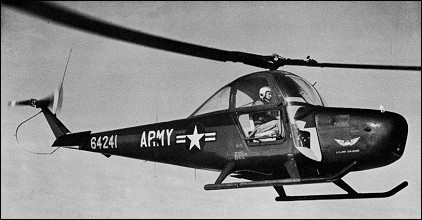|
|
The Cessna Aircraft Company was founded by Clyde Cessna, who even before World War I was at work in the American aircraft industry. The company ceased operations during the economic depression of the 1930s, but revived vigorously during World War II, when it produced trainers and utility cargo aircraft for the United States Air Force and the Royal Canadian Air Force, as well as the 750 CGA gliders used in that war. Following World War II, Cessna brought out several luxury sporting aircraft, the Models 190 and 195, and also, at the end of 1951, the well-known Model 170.
Cessna first took an interest in helicopters when it acquired the patents and rights owned by Seibel, Seibel himself becoming chief designer of the Cessna Helicopter Division.
This rotorcraft is of all-metal construction, and its lines recall those of Cessna fixed-wing aircraft, while the two-bladed rotor, designed by Seibel, also recalls that of the Seibel helicopter.
The rotor blades are attached to the hub by light-weight stainless steel L-shaped angles, which carry the blades' centrifugal load: the short leg takes up the loads due to blade weight, the long leg the bending load caused by drag. As in the Seibel helicopter, this assembly not only provides angle movement for changing blade pitch but also eliminates trunnions, thrust bearings, hinges, etc. The supercharged engine is placed in the forepart of the fuselage, thus leaving more space for cargo or passengers in the cabin, which is that of a fixed-wing aircraft.
The first prototype flew in July 1953. In 1955 a CH-1 successfully landed on, and took off from Pike's Peak, Colorado, at a height of 4300 metres. P.Lambermont "Helicopters and Autogyros of the World", 1958
Shortly after its 1952 acquisition of the Seibel Helicopter Company, Cessna undertook development of an innovative light helicopter it designated the CH-1. The aircraft made its maiden flight in 1954, and in 1957 the Army purchased ten examples of the advanced commercial model CH-1B for test and evaluation. These machines, serials 56-4236 through -4245, were allocated the designation YH-41.
The YH-41 was of all-metal construction and provided seating for a pilot and up to three passengers in a cabin closely resembling that of one of Cessna's light fixed-wing aircraft. The Seneca was powered by a single nose-mounted 260hp supercharged Continental piston engine driving the two-bladed main and anti-torque rotors via a shaft which passed between the two forward seats.
The Army's evaluation of the YH-41 showed it to be an excellent high altitude performer, though the type's limited payload and rather complex maintenance requirements precluded its large scale procurement by the Army. The ten YH-41�s were eventually relegated to miscellaneous flight test duties, most having to do with high-altitude helicopter operations, and in 1962 the surviving aircraft were redesignated NH-41A�s. S.Harding "U.S.Army Aircraft since 1947", 1990
| Technical data for CH-1
Number of seats: 2,
engine: 1 x Continental FSO-470-A rated 260hp,
rotor diameter: 10.66m,
fuselage length: 9.78m,
fuselage width: 1.63m,
height: 2.53m,
gross weight: 1360kg,
empty weight: 896kg,
max. speed: 195km/h,
cruising speed: 160km/h,
rate of climb: 351m/min,
range: 432km
|
Warning: mysqli_connect(): php_network_getaddresses: getaddrinfo for mysql5.zone.ee failed: Name or service not known in /data03/virt15346/domeenid/www.aviastar.org/htdocs/helicopters_eng/cessna_seneca.php on line 92
Fatal error: Uncaught mysqli_sql_exception: php_network_getaddresses: getaddrinfo for mysql5.zone.ee failed: Name or service not known in /data03/virt15346/domeenid/www.aviastar.org/htdocs/helicopters_eng/cessna_seneca.php:92
Stack trace:
#0 /data03/virt15346/domeenid/www.aviastar.org/htdocs/helicopters_eng/cessna_seneca.php(92): mysqli_connect('mysql5.zone.ee', 'd14657sa18989', Object(SensitiveParameterValue))
#1 {main}
thrown in /data03/virt15346/domeenid/www.aviastar.org/htdocs/helicopters_eng/cessna_seneca.php on line 92
|





